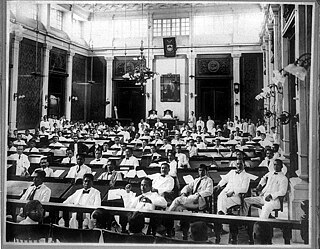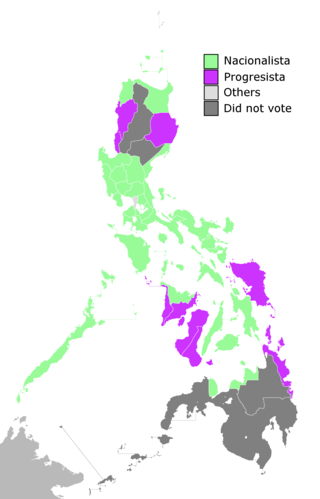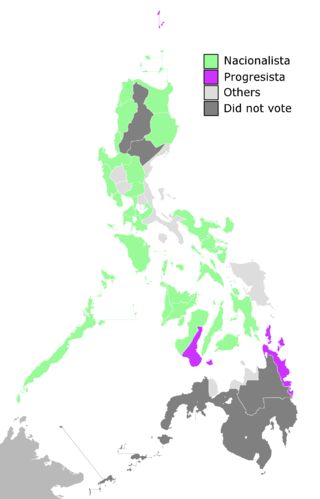| ||
 |
|---|
Local elections were held December 14, 1937 in the Philippines. All Philippine women were allowed to vote and elect among them into public offices. One of the famous examples is the election of Carmen Planas as Councilor of the City of Manila.
| ||
 |
|---|
Local elections were held December 14, 1937 in the Philippines. All Philippine women were allowed to vote and elect among them into public offices. One of the famous examples is the election of Carmen Planas as Councilor of the City of Manila.

The Senate of the Philippines is the upper house of Congress, the bicameral legislature of the Philippines with the House of Representatives as the lower house. The Senate is composed of 24 senators who are elected at-large under plurality-at-large voting.

The Philippine Assembly was the lower house of the Philippine Legislature from 1907 to 1916, when it was renamed the House of Representatives of the Philippines. The Philippine Assembly was the first national legislative body fully chosen by elections.

The Jones Law was an Organic Act passed by the United States Congress. The law replaced the Philippine Organic Act of 1902 and acted as a constitution of the Philippines from its enactment until 1934, when the Tydings–McDuffie Act was passed. The Jones Law created the first fully elected Philippine legislature.

The Philippine Legislature was the legislature of the Philippines from 1907 to 1935, during the American colonial period, and predecessor of the current Congress of the Philippines. It was bicameral and the legislative branch of the Insular Government.

The First Philippine Legislature was the first session of the Philippine Legislature, the first representative legislature of the Philippines. Then known as the Philippine Islands, the Philippines under the sovereign control of the United States through the Insular Government. The Philippine Legislature consisted of an appointed upper house, the Philippine Commission, and an elected lower house, the Philippine Assembly. These bodies were the predecessors of the Philippine Senate and Philippine House of the Philippine Congress.

Legislative elections were held on June 5, 1934 in the Philippines. Manuel L. Quezon and Sergio Osmeña were re-elected in the Philippine Senate and still arch-rivals since the Nacionalista Party broke up in 1922.

Philippine Assembly elections were held in the Philippines on November 2, 1909.

Philippine Assembly and local elections were held in the Philippines on June 4, 1912.

Senatorial elections happened on June 3, 1919 in the Philippines under the Jones Law provisions. There were 717,295 registered voters, of whom 672,122, or 92 percent, voted.

Senatorial elections happened on June 2, 1925 in the Philippines under the Jones Law provisions.
Legislative elections happened on June 5, 1928, in the Philippines under the Jones Law provisions.
The elections for the Malolos Congress, also known as the Revolutionary Congress, were held in the Philippines from June 23 to September 10, 1898.
The Constitution of the Philippines is the constitution or the supreme law of the Republic of the Philippines. Its final draft was completed by the Constitutional Commission on October 12, 1986, and ratified by a nationwide plebiscite on February 2, 1987.

The 1965 Philippine presidential and vice presidential elections were held on November 9, 1965. Incumbent President Diosdado Macapagal lost his opportunity to get a second full term as president of the Philippines to Senate President Ferdinand Marcos. His running mate, Senator Gerardo Roxas, lost to former vice president Fernando Lopez. Emmanuel Pelaez, who resigned in the Cabinet and from the Liberal Party, then sought the Nacionalista Party presidential nomination and lost it to Marcos, did not run for vice president and instead ran in the House of Representatives as an independent. An unprecedented twelve candidates ran for president; however, nine of those won 200 votes or less.

The 1961 Philippine presidential and vice presidential elections were held on November 14, 1961. Incumbent president Carlos P. Garcia lost his opportunity for a second full term as president of the Philippines to Vice President Diosdado Macapagal. His running mate, Senator Gil J. Puyat, lost to Senator Emmanuel Pelaez. Six candidates ran for president, four of whom got nine votes nationwide together. This was the only election in Philippine electoral history in which a vice-president defeated the incumbent president.

The 1957 Philippine presidential and vice presidential elections were held on November 12, 1957. Incumbent President and Vice President to Ramon Magsaysay, Carlos P. Garcia was elected for a full term as President of the Philippines. Garcia assumed the post following the death of Magsaysay in a plane crash earlier that year. His running mate, Speaker Jose Laurel Jr., lost to Pampanga Representative Diosdado Macapagal. This was the first time in Philippine electoral history wherein a president was elected by a plurality rather than a majority, and in which the winning presidential and vice presidential candidates came from different parties.

The 1995 Philippine general election were held on May 8, 1995. Filipinos protected the ballot boxes with their lives and campaigned against traditional politicians who used bribery, flying voters, violence, election rigging, stealing of ballot boxes, etc. The Philippine National Police (PNP) listed five people dead and more than 200 hotspots before and 300 hotspots during the election.

The Insular Government of the Philippine Islands was an unincorporated territory of the United States that was established in 1902 and was reorganized in 1935 in preparation for later independence. The Insular Government was preceded by the United States Military Government of the Philippine Islands and was followed by the Commonwealth of the Philippines.
Barangay elections were held on Monday, October 28, 2013. The election shall elect the Punong Barangay, more commonly known as barangay captains, and members of the Sangguniang Barangay, or barangay council, in 42,028 barangays throughout the Philippines whose terms start on November 30, 2013. Barangays are the smallest local government unit in the Philippines.

A general election in the Philippines took place on May 9, 2016, for executive and legislative branches for all levels of government – national, provincial, and local, except for the barangay officials.